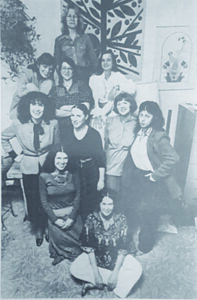Throughout art history, artists have sought out their own to develop a camaraderie that strengthened their artistic visions. The Impressionists, the Cubists, and others provided support and encouragement to make their expression of art better. Even in Peoria, there was the Peoria Sketch Club, headed by Hedley Waycott, establishing the definitive Midwestern Landscape painting style in the late 1880s.
The Irascibles or Irascible 18 were the labels given to a group of American abstract painters who penned an Open Letter, written in 1950, to the Metropolitan Museum of Art, rejecting the museum’s exhibition American Painting Today — 1950 and boycotting it on their principles of individual expression through gestural abstract painting. The subsequent coverage of the protest and a now iconic group photograph, that appeared in Life magazine, gave them notoriety and established them as the so-called first generation of the putative movement.
It is amazing that a photograph — though worth a thousand words — could introduce the world to a movement that would change the evolving history of Art, heavily reliant on, most notably, the Impressionists and Post-Impressionists and the Renaissance artists. These were artists who broke new ground in process, application and personal interpretation of art. Essentially, the Abstract artists allowed any expression, with intention, to be considered Art.

This photo of the Artistudio group was take in 1979 during Illinois Arts Week. The artists were Mary P.D. Heintzman, Wendy Hatch, Mary Ruth Ginn, Carol Hill, George Ann Danehower, Donna Janssen, Duffy Armstrong, Betty Mayers, Laura Simpson-Boyle and Barbara Melcher.
PHOTO COURTESY OF PEORIA ART GUILD
In Peoria in the 1970s, a group of women artists collectively met and established the Artistudio. The founding members included: Mary Ruth Adams Ginn, Duffy Armstrong Ferrell, George Ann Danehower, Mary P. D. Heintzman, Carol Hill, Donna Janssen, Betty Mayers, Pam Myers, Laura Simpson-Boyle, and Constance Taylor-Ohlrich. Later Cathie Crawford and Barbara Melcher joined this progressive group of artists.
These women were not only creative but were leaders in the Peoria area for many years. Their backgrounds and life experiences gave this women’s group cultural and ethnic diversity as well as incredible investment in our community. All of these women were career professionals who enriched our community with talents beyond simple creativity.
Duffy Armstrong Ferrell was Lakeview Museum’s second Curator of Education and later returned as their Public Relations Director. From experiences at these tenures, Duffy was then Director of the Peoria Art Guild and became instrumental in developing Advancement in the Arts at Bradley University. George Ann Danehower followed Armstrong as the third Curator of Education at Lakeview Museum of Arts and Sciences as well as the first Director of University Galleries at Bradley. The university was seen as a progressive institution not only through its female founder, but for having a faculty that included women in all areas. Nita Sunderland and Wendy Hatch were faculty members and significantly added growth to the Art Department.
Mary Ruth Ginn was an educational force all unto herself. She taught for decades in public schools, and, upon retirement, taught at Bradley and Illinois Central College. Dedicated to introducing youth to the world of art, she would share her passion and knowledge with them giving them first-hand experience by attending gallery and museum openings. Her personal interest in her students always resulted in passionate and expressive works of art that amazed even her. Cathie Crawford followed in her footsteps teaching high school students the basics of art that would allow many of them to pursue college degrees in art. Throughout her international travels, Crawford always sought out and involved herself in the arts of that culture.
When the University of Illinois College of Medicine opened its Peoria campus, Betty Mayer was its first medical illustrator. Her deft ability for illustration, details, and incredible rendering was necessary before there were virtual possibilities. Mary Heintzman was also an alum of Bradley and contributed to promoting and educating others in the arts on the collegiate level as well as at the Art Guild. From 2000-2003 she was the Artistic Director for Eco-Earth Globe where she continues to work with artists to repair and replace icons and tiles for the Eco-Earth restoration. Currently she teaches at Blanchet Catholic High School in Salem, Ore., where she earned the Distinguished Educator Award in 2008.
These women not only served as role models for young artists, but they continued to promote and support the appreciation of the arts in central Illinois. Through their efforts, the arts thrive and continue to grow on the back of their legacy.
This exhibition has been organized in conjunction with the biennial Midwest Women Artists Symposium held at Bradley University. Initially, this project was organized by Channy Lyons in 2011 with the goals of establishing an interdisciplinary conference exploring art, experiences and legacies of women artists working in the Midwest. Presentations focus on women who have made valuable cultural contributions, taught and invested in businesses, established community organizations and participated in political causes supporting cultural and art enrichment in the Midwest. This year’s Symposium “Women’s Work: Feminist Women Artists in the Midwest,” is being held Oct. 19-21 at Bradley.
“Artiststudio: Women Artists of Peoria” is currently at the Peoria Art Guild through the end of October. Gallery hours are 9 a.m.-4:30 p.m. Monday through Friday Admission is free and open to the public.
Information regarding The Midwest Women Artists Symposium can be obtained by contacting Kristan McKinsey at (309) 677-2860 or kmckinsey@fsmail.bradley.edu.


Recent Comments